Dynamics of bacterial communities during solid-state fermentation using agro-industrial
- 格式:pdf
- 大小:476.90 KB
- 文档页数:9
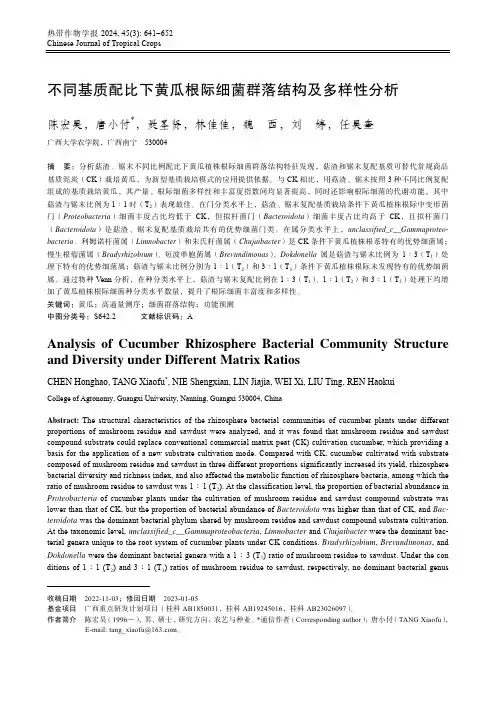
热带作物学报2024, 45(3): 641 652Chinese Journal of Tropical Crops不同基质配比下黄瓜根际细菌群落结构及多样性分析陈宏昊,唐小付*,聂圣贤,林佳佳,魏西,刘婷,任昊奎广西大学农学院,广西南宁 530004摘要:分析菇渣、锯末不同比例配比下黄瓜植株根际细菌群落结构特征发现,菇渣和锯末复配基质可替代常规商品基质泥炭(CK)栽培黄瓜,为新型基质栽培模式的应用提供依据。
与CK相比,用菇渣、锯末按照3种不同比例复配组成的基质栽培黄瓜,其产量、根际细菌多样性和丰富度指数间均显著提高,同时还影响根际细菌的代谢功能,其中菇渣与锯末比例为1∶1时(T2)表现最佳。
在门分类水平上,菇渣、锯末复配基质栽培条件下黄瓜植株根际中变形菌门(Proteobacteria)细菌丰度占比均低于CK,但拟杆菌门(Bacteroidota)细菌丰度占比均高于CK,且拟杆菌门(Bacteroidota)是菇渣、锯末复配基质栽培共有的优势细菌门类。
在属分类水平上,unclassified_c__Gammaproteo-bacteria、利姆诺杆菌属(Limnobacter)和朱氏杆菌属(Chujaibacter)是CK条件下黄瓜植株根系特有的优势细菌属;慢生根瘤菌属(Bradyrhizobium)、短波单胞菌属(Brevundimonas)、Dokdonella属是菇渣与锯末比例为1∶3(T1)处理下特有的优势细菌属;菇渣与锯末比例分别为1∶1(T2)和3∶1(T3)条件下黄瓜植株根际未发现特有的优势细菌属。
通过物种Venn分析,在种分类水平上,菇渣与锯末复配比例在1∶3(T1)、1∶1(T2)和3∶1(T3)处理下均增加了黄瓜植株根际细菌种分类水平数量,提升了根际细菌丰富度和多样性。
关键词:黄瓜;高通量测序;细菌群落结构;功能预测中图分类号:S642.2 文献标识码:AAnalysis of Cucumber Rhizosphere Bacterial Community Structure and Diversity under Different Matrix RatiosCHEN Honghao, TANG Xiaofu*, NIE Shengxian, LIN Jiajia, WEI Xi, LIU Ting, REN HaokuiCollege of Agronomy, Guangxi University, Nanning, Guangxi 530004, ChinaAbstract: The structural characteristics of the rhizosphere bacterial communities of cucumber plants under different proportions of mushroom residue and sawdust were analyzed, and it was found that mushroom residue and sawdust compound substrate could replace conventional commercial matrix peat (CK) cultivation cucumber, which providing a basis for the application of a new substrate cultivation mode. Compared with CK, cucumber cultivated with substrate composed of mushroom residue and sawdust in three different proportions significantly increased its yield, rhizosphere bacterial diversity and richness index, and also affected the metabolic function of rhizosphere bacteria, among which the ratio of mushroom residue to sawdust was 1∶1 (T2). At the classification level, the proportion of bacterial abundance in Proteobacteria of cucumber plants under the cultivation of mushroom residue and sawdust compound substrate was lower than that of CK, but the proportion of bacterial abundance of Bacteroidota was higher than that of CK, and Bac-teroidota was the dominant bacterial phylum shared by mushroom residue and sawdust compound substrate cultivation. At the taxonomic level, unclassified_c__Gammaproteobacteria, Limnobacter and Chujaibacter were the dominant bac-terial genera unique to the root system of cucumber plants under CK conditions. Bradyrhizobium, Brevundimonas, and Dokdonella were the dominant bacterial genera with a 1∶3 (T1) ratio of mushroom residue to sawdust. Under the con ditions of 1∶1 (T2) and 3∶1 (T3) ratios of mushroom residue to sawdust, respectively, no dominant bacterial genus收稿日期 2022-11-03;修回日期 2023-01-05基金项目 广西重点研发计划项目(桂科AB1850031,桂科AB19245016,桂科AB23026097)。
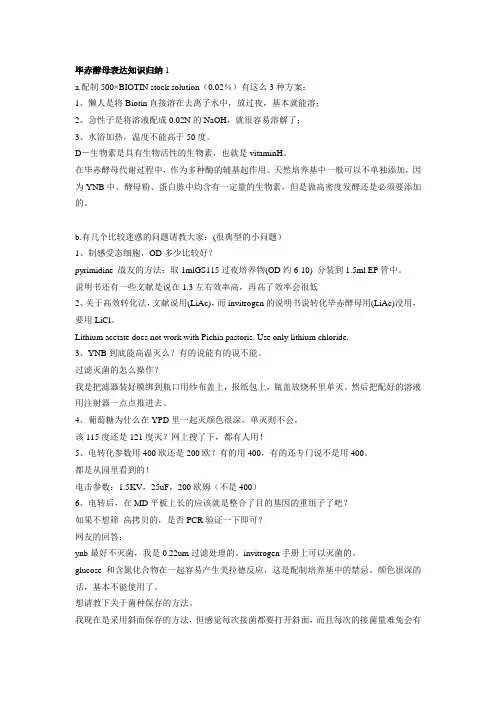
毕赤酵母表达知识归纳1a.配制500×BIOTIN stock solution(0.02%)有这么3种方案:1、懒人是将Biotin直接溶在去离子水中,放过夜,基本就能溶;2、急性子是将溶液配成0.02N的NaOH,就很容易溶解了;3、水浴加热,温度不能高于50度。
D-生物素是具有生物活性的生物素,也就是vitaminH。
在毕赤酵母代谢过程中,作为多种酶的辅基起作用。
天然培养基中一般可以不单独添加,因为YNB中、酵母粉、蛋白胨中均含有一定量的生物素,但是做高密度发酵还是必须要添加的。
b.有几个比较迷惑的问题请教大家:(很典型的小问题)1、制感受态细胞,OD多少比较好?pyrimidine 战友的方法:取1mlGS115过夜培养物(OD约6-10) 分装到1.5ml EP管中。
说明书还有一些文献是说在1.3左右效率高,再高了效率会很低2、关于高效转化法,文献说用(LiAc),而invitrogen的说明书说转化毕赤酵母用(LiAc)没用,要用LiCl。
Lithium acetate does not work with Pichia pastoris. Use only lithium chloride.3、YNB到底能高温灭么?有的说能有的说不能。
过滤灭菌的怎么操作?我是把滤器装好膜绑到瓶口用纱布盖上,报纸包上,瓶盖放烧杯里单灭。
然后把配好的溶液用注射器一点点推进去。
4、葡萄糖为什么在YPD里一起灭颜色很深,单灭则不会。
该115度还是121度灭?网上搜了下,都有人用!5、电转化参数用400欧还是200欧?有的用400,有的还专门说不是用400。
都是从园里看到的!电击参数:1.5KV,25uF,200欧姆(不是400)6、电转后,在MD平板上长的应该就是整合了目的基因的重组子了吧?如果不想筛高拷贝的,是否PCR验证一下即可?网友的回答:ynb最好不灭菌,我是0.22um过滤处理的。
invitrogen手册上可以灭菌的。

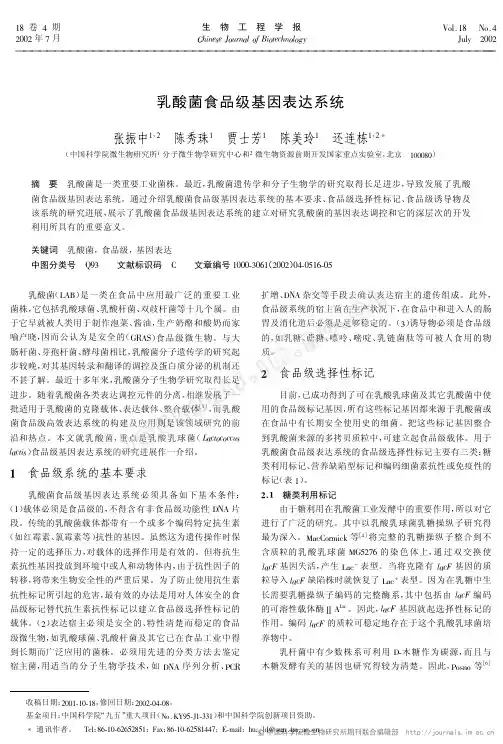
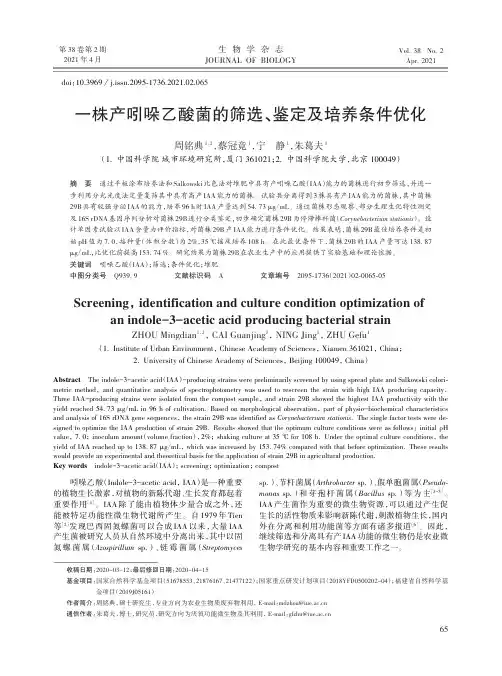
doi :10.3969/j.issn.2095⁃1736.2021.02.065一株产吲哚乙酸菌的筛选、鉴定及培养条件优化周铭典1,2,蔡冠竟1,宁静1,朱葛夫1(1.中国科学院城市环境研究所,厦门361021;2.中国科学院大学,北京100049)摘要通过平板涂布培养法和Salkowski 比色法对堆肥中具有产吲哚乙酸(IAA )能力的菌株进行初步筛选,并进一步利用分光光度法定量复筛其中具有高产IAA 能力的菌株。
试验共分离得到3株具有产IAA 能力的菌株,其中菌株29B 具有较强分泌IAA 的能力,培养96h 时IAA 产量达到54.73μg /mL 。
通过菌株形态观察、部分生理生化特性测定及16S rDNA 基因序列分析对菌株29B 进行分类鉴定,初步确定菌株29B 为停滞棒杆菌(Corynebacterium stationis )。
设计单因素试验以IAA 含量为评价指标,对菌株29B 产IAA 能力进行条件优化。
结果表明,菌株29B 最佳培养条件是初始pH 值为7.0,接种量(体积分数)为2%,35℃摇床培养108h 。
在此最优条件下,菌株29B 的IAA 产量可达138.87μg /mL ,比优化前提高153.74%。
研究结果为菌株29B 在农业生产中的应用提供了实验基础和理论依据。
关键词吲哚乙酸(IAA );筛选;条件优化;堆肥中图分类号Q939.9文献标识码A文章编号2095⁃1736(2021)02⁃0065⁃05Screening ,identification and culture condition optimization ofan indole-3-acetic acid producing bacterial strainZHOU Mingdian 1,2,C AI Guanjing 1,N ING Jing 1,Z HU Gefu 1(1.Institute of Urban Environment ,C hinese Academy of Sciences ,X iamen 361021,C hina ;2.University of Chinese Academy of Sciences ,B eijing 100049,C hina )Abstract The indole-3-acetic acid (IAA )-producing strains were preliminarily screened by using spread plate and Salkowski colori⁃metric method ,a nd quantitative analysis of spectrophotometry was used to rescreen the strain with high IAA producing capacity.Three IAA-producing strains were isolated from the compost sample ,a nd strain 29B showed the highest IAA productivity with the yield reached 54.73μg /mL in 96h of cultivation.Based on morphological observation ,p art of physio-biochemical characteristics and analysis of 16S rDNA gene sequences ,t he strain 29B was identified as Corynebacterium stationis .The single factor tests were de⁃signed to optimize the IAA production of strain 29B.Results showed that the optimum culture conditions were as follows :initial pH value ,7.0;i noculum amount (volume fraction ),2%;s haking culture at 35℃for 108h.Under the optimal culture conditions ,t he yield of IAA reached up to 138.87μg /mL ,w hich was increased by 153.74%compared with that before optimization.These results would provide an experimental and theoretical basis for the application of strain 29B in agricultural production.Key words indole-3-acetic acid (IAA );screening ;optimization ;compost吲哚乙酸(Indole-3-acetic acid ,I AA )是一种重要的植物生长激素,对植物的新陈代谢、生长发育都起着重要作用[1]。
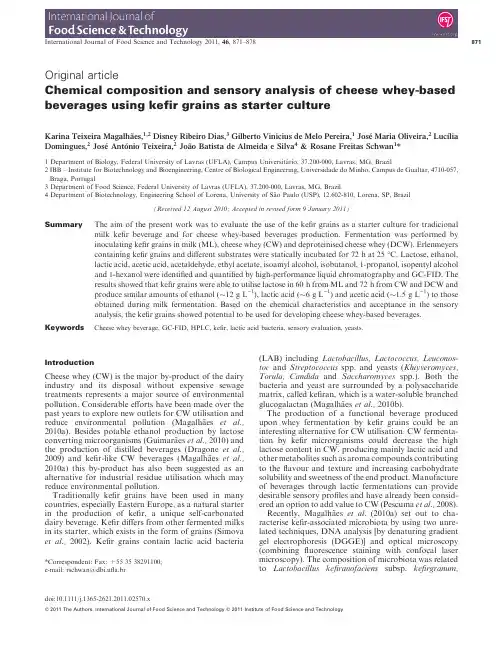
Original articleChemical composition and sensory analysis of cheese whey-based beverages using kefir grains as starter cultureKarina Teixeira Magalha˜es,1,2Disney Ribeiro Dias,3Gilberto Vinicius de Melo Pereira,1Jose ´Maria Oliveira,2Lucı´lia Domingues,2Jose´Anto ´nio Teixeira,2Joa ˜o Batista de Almeida e Silva 4&Rosane Freitas Schwan 1*1Department of Biology,Federal University of Lavras (UFLA),Campus Universitario,37.200-000,Lavras,MG,Brazil 2IBB –Institute for Biotechnology and Bioengineering,Centre of Biological Engineering,Universidade do Minho,Campus de Gualtar,4710-057,Braga,Portugal3Department of Food Science,Federal University of Lavras (UFLA),37.200-000,Lavras,MG,Brazil 4Department of Biotechnology,Engineering School of Lorena,University of Sa o Paulo (USP),12.602-810,Lorena,SP,Brazil(Received 12August 2010;Accepted in revised form 9January 2011)SummaryThe aim of the present work was to evaluate the use of the kefir grains as a starter culture for tradicionalmilk kefir beverage and for cheese whey-based beverages production.Fermentation was performed by inoculating kefir grains in milk (ML),cheese whey (CW)and deproteinised cheese whey (DCW).Erlenmeyers containing kefir grains and different substrates were statically incubated for 72h at 25°ctose,ethanol,lactic acid,acetic acid,acetaldehyde,ethyl acetate,isoamyl alcohol,isobutanol,1-propanol,isopentyl alcohol and 1-hexanol were identified and quantified by high-performance liquid chromatography and GC-FID.The results showed that kefir grains were able to utilise lactose in 60h from ML and 72h from CW and DCW and produce similar amounts of ethanol ( 12g L )1),lactic acid ( 6g L )1)and acetic acid ( 1.5g L )1)to those obtained during milk fermentation.Based on the chemical characteristics and acceptance in the sensory analysis,the kefir grains showed potential to be used for developing cheese whey-based beverages.KeywordsCheese whey beverage,GC-FID,HPLC,kefir,lactic acid bacteria,sensory evaluation,yeasts.IntroductionCheese whey (CW)is the major by-product of the dairy industry and its disposal without expensive sewage treatments represents a major source of environmental pollution.Considerable efforts have been made over the past years to explore new outlets for CW utilisation and reduce environmental pollution (Magalha es et al.,2010a).Besides potable ethanol production by lactose converting microorganisms (Guimara es et al.,2010)and the production of distilled beverages (Dragone et al.,2009)and kefir-like CW beverages (Magalha es et al.,2010a)this by-product has also been suggested as an alternative for industrial residue utilisation which may reduce environmental pollution.Traditionally kefir grains have been used in many countries,especially Eastern Europe,as a natural starter in the production of kefir,a unique self-carbonated dairy beverage.Kefir differs from other fermented milks in its starter,which exists in the form of grains (Simova et al.,2002).Kefir grains contain lactic acid bacteria(LAB)including Lactobacillus,Lactococcus,Leuconos-toc and Streptococcus spp.and yeasts (Kluyveromyces,Torula,Candida and Saccharomyces spp.).Both the bacteria and yeast are surrounded by a polysaccharide matrix,called kefiran,which is a water-soluble branched glucogalactan (Magalha es et al.,2010b).The production of a functional beverage produced upon whey fermentation by kefir grains could be an interesting alternative for CW utilisation.CW fermenta-tion by kefir microrganisms could decrease the high lactose content in CW,producing mainly lactic acid and other metabolites such as aroma compounds contributing to the flavour and texture and increasing carbohydrate solubility and sweetness of the end product.Manufacture of beverages through lactic fermentations can provide desirable sensory profiles and have already been consid-ered an option to add value to CW (Pescuma et al.,2008).Recently,Magalha es et al.(2010a)set out to cha-racterise kefir-associated microbiota by using two unre-lated techniques,DNA analysis [by denaturing gradient gel electrophoresis (DGGE)]and optical microscopy (combining fluorescence staining with confocal laser microscopy).The composition of microbiota was related to Lactobacillus kefiranofaciens subsp.kefirgranum,*Correspondent:Fax:+553538291100;e-mail:rschwan@dbi.ufla.brInternational Journalof Food Science and Technology 2011,46,871–878871doi:10.1111/j.1365-2621.2011.02570.xÓ2011The Authors.International Journal of Food Science and Technology Ó2011Institute of Food Science and TechnologyLactobacillus kefiranofaciens subsp.kefiranofaciens,an uncultured bacterium related to the genus Lactobacillus, Kluyveromyces marxianus,Saccharomyces cerevisiae and Kazachstania unispora.No differences were found in the community structure detected in the analysed beverage and Brazilian kefir grains,showing that microbiota of kefir grains is highly stable along the fermentations carried out in different substratum.However,this characterisation was restricted to the microbiota and until recently,we were not aware of any reports concerning the chemical and sensorial characterisation of these beverages.Therefore,the aim of the present work was to evaluate the use of the kefir grains as a starter culture for traditional milk kefir beverage and for CW-based beverages production,besides evaluating the biochem-ical changes,organic acids production and volatile compounds formation during fermentation process. Materials and methodsCW-based and milk fermentation mediaThree different substrates containing lactose concentra-tion of46g L)1were used as fermentation media: pasteurised full cows milk(ML),CW and deproteinised cheese whey(DCW).CW powder,obtained from a regional dairy industry(Lactogal,Porto,Portugal),was dissolved in sterile distilled water until the desired lactose concentration.DCW was made by autoclaving at115°C for10min the CW solution,followed by aseptic centrifugation(2220g for20min)to remove cream.Confirmation of CW deproteinisation was accomplished for Kjeldahl method.Kefir beverages productionBrazilian kefir grains were employed in the present study.The grains(12.5g)were washed with sterile distilled water and inoculated in250mL of ML,CW and DCW.The milk is used commonly for kefir beverage,therefore was used to compare the fermenta-tion with CW kefir beverages.Erlenmeyers containing kefir grains were statically incubated for72h at25°C. Samples of the kefir beverages were aseptically taken every12h for analysis of organic acids,ethanol,sugars and volatileflavour substances.Determination of total reducing sugars was used to assess the substrate consumption.The pH of the fermented beverages was measured using a Micronal B474pH meter.Two replicates were done in each fermentation batch. Analytical methodsChemicals1-Hexanol and ethyl acetate were purchased from Aldrich Chemistry(Munich,Germany).1-propanol,2-methyl-1-propanol,2-methyl-1-butanol,3-methyl-1-butanol were purchased from Fluka Analyticals(Seelze, Germany).Ethyl acetate,Acetaldeyde lactose,were purchased from Sigma-Aldrich(St Louis,MO,USA) and acetic acid,lactic acid,ethanol,methanol were purchased from Merck(Darmstadt,Germany). Organic acids,sugars and ethanolLactose and ethanol were quantified by high-perfor-mance liquid chromatography(HPLC),using a Jasco chromatograph equipped with a refractive index(RI) detector(Jasco830-RI,Madrid,Spain).Lactic acid and acetic acid were also quantified by HPLC,using a Jasco chromatograph equipped with UV–Visible detector (Jasco870-UV-visible).A Chrompack column(300·6.5mm)at60°C,using5mM sulphuric acid as the eluent,at aflow rate of0.5mL min)1and a sample volume of20l L was used.Volatileflavour substancesIn order to identify the volatile compounds,the kefir beverages were analysed directly without any previous treatment according to Fraile et al.(2000).A Chrompack CP-9000gas chromatograph equipped with a Split⁄Split-less injector,aflame ionisation detector,and a capillary column(50m·0.25mm i.d.,0.2l mfilm thickness; Chrompack)coated with CP-Wax57CB was used.The temperature of the injector and detector was set to250°C. The oven temperature was held at50°C for5min,then programmed to run from50°C to220°C at3°C min)1and then held at220°C for10min.Helium was used as the carrier gas at125kPa,with a split vent of15mL min)1. Injections of1l L were made in the splitless mode(vent time,15s);4-nonanol(internal standard)was added to the sample to afinal concentration of122.05mg L)1.The volatile compounds were identified by comparing the retention times of the samples with those of standard compounds.Quantification of volatile compounds was performed with Varian Star Chromatography Worksta-tion software(Version6.41)and expressed as4-nonanol equivalents,after determining the detector response factor for each compound.Sensory evaluationThefinal kefir beverages(ML,CW and DCW)were evaluated by twenty-five untrained tasters,males and females,25–35years of age(students of the Centre of Biological Engineering,University of Minho,Campus Gualtar,Braga,Portugal).Randomised,refrigerated (10°C)samples of10mL were served(containing 1.0mg of sucrose)in clear,tulip-shaped glasses with a volume of50mL;these were marked with three digit random numbers and covered with Petri dishes.Dis-tilled water was provided for rinsing of the palate during the testing.Tasters were asked to indicate how much they liked or disliked each product on a9-point hedonicChemical and sensory analysis of CW-based kefir beverages K.T.Magalha˜es et al.872International Journal of Food Science and Technology2011Ó2011The AuthorsInternational Journal of Food Science and TechnologyÓ2011Institute of Food Science and Technologyscale(9=like extremely;1=dislike extremely)according to colour,odour,aroma,appearance,tasteand overall acceptability characteristics.Statistical analysisStatistical analysis was carried out with Statistica soft-ware version9.0(StatSoft Inc.,Tulsa,OK,USA).Principal component Analysis(PCA)was used tosummarise the information in a reduced number ofprincipal components.A one-way anova was performedfor chemical parameters,concentration of volatile com-pounds values to determine significant differences(P<0.05)by using the Duncan’s multiple range testusing the spss version10.0.Results and discussionMicrobial metabolitesMilk and CW-based kefir beverages were monitoredduring the72h fermentation period by determining theacidity.During the72h of incubation,pH values of thefermented milk kefir and whey-based beverages rangedfrom6.1to3.9,notfinding significant differences for allthe substrates(P<0.05)(data not shown).These pHvalues were similar to those previously reported for kefirbeverage(Magalha es et al.,2010b).pH is an importantfactor that can strongly affect the quality of a beverage(Sharma et al.,2009).Furthermore,pH values of thefermentation broth significantly influence the fermenta-tion time of lactose and the levels of volatile compounds,reflecting possible variations in the sensory characteris-tics of thefinal product(Athanasiadis et al.,2004).High performance liquid chromatography(HPLC)was used to analyse organic acids,ethanol e sugars inthe produced kefir beverages.The Figs1–3show theconcentration of sugars,organic acids and ethanolobtained by ML,CW and DCW fermentation.Theproduction process of organic acids and alcohol wasfollowed by the lactose consumption in kefir beverages(ML,CW and DCW).The total lactose consumptionwas observed in60h in the ML fermentation and72hin the CW and DCW fermentation(Figs1–3).Thislikely reflects an adaptation period of the microbialcommunity to the whole and deproteinised CW as kefirgrains are fermented in milk ctose readilydegraded to galactose and glucose by Group N strep-tococci,Lactobacillus and by some strains of Kluyver-omyces(Gu zel-Seydim et al.,2000).In the present work,the lactic acid content increasedduring the72h of fermentation process in kefir bever-ages,reaching maximum value of6.35g L)1,6.34g L)1and6.81g L)1in ML,CW and DCW kefir beverages,respectively(Figs1–3).The fermentation of lactose by LAB present in kefir culture can be associated with the increase in lactic acid production through the hydrolysis of sugars released from the glycomacropeptide of casein as well as the glycoproteins associated with the fat globule membrane(Rynne et al.,2007).Acetic acid was also formed during the fermentation process of kefir beverages(ML,CW and DCW),reaching maximum value of 1.5g L)1(Figs1–3).The acetic acid was formed probably by heterolactic bacteria,previously identified in Brazilian kefir beverages(Magalha es et al., 2010b).These results are of great importance since lactic acid and acetic acid provides pleasant taste and inhibits the development of undesirable or pathogenic microor-ganisms,due to the substrate acidity increase(Ma-galha es et al.,2010b).Ethanol concentration increased during the kefir fermentation process in all three kefir beverages,reach-ing maximum concentration of12.26,12.72and 11.86g L)1in ML,CW and DCW kefir beverages, respectively(Figs1–3).Saccharomyces cerevisiae,previ-ously identified in kefir beverages(Magalha es et al., 2010a),which exhibits strong fermentative metabolism and tolerance to ethanol,is primarily responsible for the alcohol production(Pereira et al.,2010).However,some bacteria from the genus Lactobacillus also have the ability to produce ethanol,since they have alcohol-dehydrogenase activity,an enzyme able to convert acetaldehyde to ethanol(Magalha es et al.,2010b).The content of alcohol should be enough to give kefir the flavour of a light alcoholic beverage that is typical of traditional(ancient)kefir of the Caucasus and the yeast aroma ensures the specificity of this type of fermented beverage(Beshkova et al.,2003).Aroma-related compoundsLAB present in kefir grains starter cultures produce a plethora of enzymes that contribute to the formation of volatiles via proteolysis,lipolysis and carbohydrate degradation during ripening.Such enzymes are peptid-ases which are involved in the transformation of casein into free amino acids which are further degraded to volatile aroma compounds.Other enzymes are esterases and lipases that hydrolyse triglycerides of dairy of fat in free fatty acids(Dragone et al.,2009).GC⁄FID analysis was employed to determine volatile com-pounds in kefir beverages(ML,CW and DCW)during 72h fermentation process.The Table1shows the results of the following aroma forming compounds produced in the kefir beverages.Isoamyl alcohol(3-methyl-1-butanol),isobutanol(2-methyl-1-propanol), 1-propanol,isopentyl alcohol(2-methyl-1-butanol) and1-hexanol were the alcohols found in the kefir beverages(ML,CW and DCW)(Table1).The iden-tified ester is represented for ethyl acetate,while amongst the aldehyde group,acetaldehyde was found in kefir beverages.According to some authors(Apos-tolopoulou et al.,2005),ethyl esters(mainly ethyl acetate),alcohols with three or more carbon units,and acetaldehyde,are the major agents responsible for the flavour of fermented beverages.Ethyl acetate has a significant effect on the organo-leptic characteristics of fermented beverages.The pres-ence of this ester results in a pleasant aroma with fruity properties,but can turn vinegary at levels above 150mg L)1,adding spoilage notes to the beverage (Falque et al.,2001).Thus,the ethyl acetate concentra-tion in kefir beverages(8.18,8.27and8.38mg L)1in ML,CW and DCW,respectively)was found at a level suitable to confer a pleasantflavour.Normally,in-creased ethyl acetate concentrations are indicative of long term storage of the raw material and probable acetic bacterial spoilage.1-propanol can also be an indicator of bacterial spoilage.The lowfinal concentra-tion of1-propanol in kefir beverages(1.97mg L)1for ML,2.44mg L)1for CW and2.38mg L)1for DCW) can be compared with levels of other beverages,such as whiskies and cider brandies(Apostolopoulou et al., 2005).The concentration of2-methyl-1-propanol in kefir beverages(Table1)can also be well compared with levels in other beverages(Apostolopoulou et al.,2005; Dragone et al.,2009).Amyl alcohols(3-methyl-1-butanol and2-methyl-1-butanol)are formed during fermentation by deamina-tion and decarboxylation reactions from isoleucine and leucine,respectively(Dragone et al.,2009).Such com-pounds constitute quantitatively the greater fraction of the alcohols in most fermented beverages(Soufleros et al.,2004).In the kefir beverages produced in our study they were found in thefinal concentration of 8.80mg L)1for2-methyl-1-butanol and 5.80mg L)1 for3-methyl-1-butanol(Table1).Increased concentra-tion of amyl alcohols can contribute negatively to the aroma of the beverages(Falque et al.,2001).The1-hexanol alcohol was also found in kefir beverages.This alcohol has a positive influence on the aroma of the fermented beverage when it occurs in concentrations up to20mg L)1.On the contrary,increased concentration of1-hexanol,seriously impairs the organoleptic charac-teristics of the beverage(Falque et al.,2001).The low 1-hexanolfinal concentration found in kefir beverages (0.5mg L)1for ML,0.57mg L)1for CW and0.58 mg L)1for DCW)can be considered to affect positively theflavour of the product.Methanol was not found in kefir beverages,that is benefic since a highly toxic effect has been reported for this compound(maximum legal limit1000g hL)1of100%vol.ethanol–Council Regulation(EEC)No.1576⁄89,1989)(Geroyiannaki et al.,2007).The absence of methanol in kefir beverages is probably due to the lack of pectin in milk and CW.Chemical and sensory analysis of CW-based kefir beverages K.T.Magalha˜es et al.874International Journal of Food Science and Technology2011Ó2011The AuthorsInternational Journal of Food Science and TechnologyÓ2011Institute of Food Science and TechnologyT a b l e 1C o n c e n t r a t i o n o f v o l a t i l e s c o m p o u n d s p r e s e n t i n k e fir b e v e r a g e s s p i r i t b y G C -F I DK e fir b e v e r a g e s f e r m e n t a t i o n C o m p o u n d s v o l a t i l eA c e t a l d e h y d e E t h y l a c e t a t e 1-P r o p a n o l 2-M e t h y l -1-p r o p a n o l (i s o b u t y l a l c o h o l )2-M e t h y l -1-b u t a n o l (i s o p e n t y l a l c o h o l )3-M e t h y l -1-b u t a n o l (i s o a m y l a l c o h o l )1-H e x a n o lM i l k (m g L )1)0h n .d n .d n .d n .d n .d n .d n .d 12h 2.16±0.02a c d e n .d n .d n .d n .d 0.08±0.04b c d e n .d 24h 2.17±1.12a c d e 2.88±1.22b c d e n .d 5.14±1.56d e 3.97±1.26d e 3.46±1.58b c d e n .d 36h 2.68±0.75a c d e 3.71±0.86b c d e n .d 5.49±1.96d e 4.20±1.67d e 4.24±0.47b c d e n .d 48h 3.38±0.65a c d e 3.77±1.30b c d e n .d 6.82±0.35d e 4.44±0.90d e 4.40±1.79b c d e n .d 60h 5.08±0.82a c d e 8.18±1.67b c d e 1.97±0.29a b 10.89±2.15d e 8.65±1.94d e 5.89±1.73b c d e 0.50±0.02a b c 72h5.08±0.82a c d e 8.18±1.67b c d e 1.97±0.29a b 10.89±2.15d e 8.65±1.94d e 5.89±1.73b c d e0.50±0.02a b cC h e e s e w h e y (m g L )1)0h n .d n .d n .d n .d n .d n .d n .d 12h 1.56±0.01b c d e 1.06±0.08c d e 0.15±0.07a b c d n .d n .d n .d n .d 24h 2.92±0.16b c d e 2.35±0.46c d e 2.54±1.22a b c d 3.99±1.10b c d e 3.84±0.14d e 5.62±0.26d e n .d .36h 3.16±0.95b c d e 2.56±1.98c d e 2.46±0.57a b c d 4.43±1.76b c d e 4.15±2.14d e 5,45±0.40d e n .d .48h 3.23±0.98b c d e 2.56±1.84c d e 2.15±0.78a b c d 4.21±0.30b c d e 4.07±0.07d e 5.73±0.05d e n .d .60h 5.97±0.11b c d e 6.42±0.19c d e 2.37±0.13a b c d 8.88±2.03b c d e 8.15±0.95d e 5.75±0.71d e 0.57±0.02a b c 72h5.98±0.17b c d e 8.27±0.37c d e 2.44±0.18a b c d 10.51±0.41b c d e 8.88±0.23d e5.91±0.16d e0.57±0.06a b cD e p r o t e i n i s e d c h e e s e w h e y (m g L )1)0h n .d n .d n .dn .d n .d n .d n .d 12h 1.39±0.11b c d e 0.98±0.03b c d e 0.10±0.01a b c d n .d .0.13±0.04e 0.27±0.24b c d e n .d .24h 2.81±0.01b c d e 2.32±0.50b c d e 2.34±0.93a b c d 3.61±0.55b c e 3.62±0.17e 5.40±0.57b c d e n .d .36h 2.80±0.04b c d e 2.56±0.57b c d e 2.31±0.04a b c d 3.94±1.07b c e 3.70±0.42e 5.37±0.52b c d e n .d .48h 3.12±0.82b c d e 2.75±0.35b c d e 2.35±0.5a b c d 4.04±0.07b c e 4.01±0.02e 5.80±0.15b c d e n .d .60h 5.95±0.08b c d e 6.30±0.36b c d e 2.39±0.16a b c d 8.22±1.10b c e 7.74±0.37e 5.83±0.74b c d e 0.59±0.01a b c 72h 5.98±0.61b c d e 8.38±0.25b c d e 2.38±0.25a b c d 10.60±0.28b c e 8.89±0.16e 5.82±0.02b c d e0.58±0.04a b c O d o u r t h r e s h o l d (m g L )1)25n §12.3m †266n 750o §–7m *à7m *à0.592n *àD e s c r i p t o r sW h e y n W h e y nW h e y n –C h e e s e m ,W h e y n C h e e s e mW h e y nD a t a a r e a v e r a g e v a l u e s o f d u p l i c a t e ±s t a n d a r d d e v i a t i o n .n .d .-n o t d e t e c t e d .*O l f a c t o r y p e r c e p t i o n t h r e s h o l d i n h y d r o -a l c o h o l i c s o l u t i o n .†O l f a c t o r y t h r e s h o l d i n m o d e l w i n e .àO l f a c t o r y p e r c e p t i o n t h r e s h o l d i n w a t e r .§O l f a c t o r y d i f f e r e n c e t h r e s h o l d i n b e e r .m E s c u d e r o e t a l .(2004).n D r a g o n e e t a l .(2009).a –e =T h e a v e r a g e s o f t h e c o l u m n s w i t h d i f f e r e n t l e t t e r a r e s i g n i fic a n t l y d i f f e r e n t (P <0.05).Chemical and sensory analysis of CW-based kefir beverages K.T.Magalha˜es et al.875Ó2011The AuthorsInternational Journal of Food Science and Technology 2011International Journal of Food Science and Technology Ó2011Institute of Food Science and TechnologyLow molecular mass carbonyl compounds such asaldehydes and ketones are normally found in fermented beverages as by-products of yeasts fermentation,inter-mediates in the formation of fusel oil and as a result of alcohol oxidation at various stages of beverage produc-tion.Nevertheless,their presence is not desirable because some of them are responsible for unpleasant organoleptic properties (Dragone et al.,2009).In the present study,acetaldehyde was the only carbonylated compound identified amongst the major volatile com-pounds,but its concentration value (5.08mg L )1for ML and 5.98mg L )1for CW and DCW)was low when compared to other beverages,such as tsipouro or grappa (Apostolopoulou et al.,2005).This low concen-tration value is interesting,because elevated acetalde-hyde concentrations give a pungent irritating odour to the beverage,and can be health hazards (Geroyiannaki et al.,2007).The results obtained for the volatile compounds (Table 1)were submitted to PCA to obtain a more simplified view of the relationships amongst the volatile compounds analysed (Fig.4).The first principal com-ponent accounted for 76.85%of the total variation,while PC2and PC3explained 13.29%and 7.86%of the total variation,respectively.A plot of the results shows the formation of four groups (Fig.4).Two of the groups are located on the first factor (X -axis positive,Y -axisnegative and Z -axis positive or negative),and includes A1,B1,C1and A2,A3,A4samples.These groups corresponded to the early times of fermentation and were far plotted of the 1-propanol,isoamyl alcohol and isopentyl alcohol point,suggesting that these volatiles compounds made significant contributions to separation between these.The third group is closely related on the second or third part of the axis (X -axis positive,Y -axis positive and Z -axis positive or negative),and includes the samples B2,B3,B4,C2,C3,and C4.These times of fermentation were mainly associated with larger con-centrations of isoamyl alcohol and 1-propanol.The following group is also closely related on the second or third part of the axis (X -axis negative,Y -axis negative and Z -axis positive or negative)and includes the samples of end fermentation (A5,A6,B5,B6,C5and C6).The final concentration of volatiles revealed only little variation amongst in the samples of beverages produced (ML,CW and DCW),confirming results (Table 1).Our results indicated a significant contribution of kefir culture in volatile compounds as the composition of organic acids,esters,acetaldehyde and alcohols.The compounds identified in in milk and CW ⁄based kefir beverages are similar to those present in other beverages,like sake (Teramoto et al.,2002),mouro (Soufleros etal.,2004).,or mescal (Leon-Rodrıguez et al.,2006)produced from Agave salmiana ,for example.Dragone et al.(2009)also found similar compounds in CW alcoholic beverage.Sensory analysisThe kefir beverages were subjected to sensory analysis to assess its acceptance.(Table 2).For all attributes assessed the beverages showed good acceptance (at least 5points or 50%of acceptance).The likeness in sensory analysis found amongst these three beverages analysed here might be the result of the similar chemical and volatile compounds compositions of these final products (Figs 1–3and Table 1).Table 2Sensory colour,appearance,taste and overall acceptabilityscores on a 9-point hedonic scale (9=like extremely;1=dislike extremely)of kefir beveragesKefir beverages Sensory propertiesColour Aroma Appearance Taste Overallacceptability Milk6.02 6.11 5.82 6.17 6.16Cheese whey 5.78 6.01 5.69 6.08 6.01Deproteinised cheese whey5.515.925.545.825.89Figure 4Principal Component Analysis (PCA)3D plot of concentra-tion of volatiles compounds of kefir beverages.Chemical and sensory analysis of CW-based kefir beverages K.T.Magalha˜es et al.876International Journal of Food Science and Technology 2011Ó2011The AuthorsInternational Journal of Food Science and Technology Ó2011Institute of Food Science and TechnologyThe traditional milk kefir beverage is commonly manufactured in different countries and is known for its organoleptic characteristics assessed.The potential for use of CW as a medium for manufacturing products with a sensory profile similar to that of fermented milk beverages was demonstrated by the results of this study,i.e.there was no evidence that,when using the kefir grains,adversely effect the substrate(CW or milk) on volatile compounds and sensory(Figs1–3and Table1).Assadi et al.,(2008)tested the technological potential of various ratios of lactic bacteria,yeasts and acetic acid bacteria isolated from kefir grains starter culture for CW fermentation.The best results were obtained when all the starter cultures were combined,i.e.bacterial mixed yeast fermentation.The potential of starter culture in production of healthy beverage from CW was found and the beverage produced good organoleptic quality and presented taste of artificial butter milk and naturally carbonated.These results confirm the good acceptable of the beverages produced in this study by kefir grains containing mixed bacterial and yeast cultures. ConclusionsKefir grains were able to reduce the lactose concentra-tion in CW producing volatile compounds for good quality of the beverages.GC-FID revealed the presence of volatile compounds in the kefir beverages.Most of these compounds are similar to those reported for other fermented beverages,although the concentration values are different.Higher alcohols(mainly isobutyl alcohol and isopentyl alcohol)and ethyl esters(mainly ethyl acetate)were the most dominant compounds present,contributing thus for the greatest proportion of the total aroma.The results of this study indicate that novel beverages of acceptable organoleptic char-acter can be produced by CW-based fermentation by kefir grains.The proposed technology in this study is environmen-tally significant due to the fact that a very polluting liquid industrial waste is employed to produce products of nutritional value,including the use of probiotic kefir grains as alternative.The one key point for industrial application of the proposed technology is the promotion of fermentation by kefir of granular biomass which provides the possibility of eliminating the use of centrifugal separators that have a high energy demand and require high industrial investment. AcknowledgmentsThe authors acknowledge thefinancial support from Coordenac a o de Aperfeic oamento de Pessoal de Nıvel Superior(CAPES),CAPES-GRICES and Lactogal for supplying CW powder.ReferencesApostolopoulou, A.A.,Flouros, A.I.,Demertzis,P.G.&Akrida-Demertzi,K.(2005).Differences in concentration of principal volatile constituents in traditional Greek distillates.Food Control, 16,157–164.Assadi,M.M.,Abdolmaleki,F.&Mokarrame,R.R.(2008).Appli-cation of whey in fermented beverage production using kefir starter culture.Nutrition&Food Science,38,21–127.Athanasiadis,I.,Paraskevopoulou,A.,Blekas,G.&Kiosseoglou,V. (2004).Development of a novel whey beverage by fermentation with kefir granules.Effect of various treatments.Biotechnology Progress, 20,1091–1095.Beshkova, D.M.,Simova, E.D.,Frengova,G.I.,Simov,Z.I.& Dimitrov,Zh.P.(2003).Production of volatile aroma compounds by kefir starter culture.International Dairy Journal,13,529–535. Dragone,G.,Mussatto,S.I,Oliveira,J.M.&Teixeira,J.A.(2009). Characterisation of volatile compounds in an alcoholic beverage produced by whey fermentation.Food Chemistry,112,929–935. Escudero,A.,Gogorza, B.,Melus,M.A.,Ortin,N.,Cacho,J.& Ferreira,V.(2004).Characterization of the aroma of a wine from Maccabeo.Key role played by compounds with low odor activity values.Journal of Agricultural and Food Chemistry,52,3516–3524. Falque,E.,Ferna ndez,E.&Dubourdieu,D.(2001).Differentiation of white wines by their aromatic index.Talanta,54,271–281. Fraile,P.,Garrido,J.&Ancın,C.(2000).Influence of a Saccharo-myces selected strain in the volatile composition of Rose wines. Evolution during fermentation.Journal of Agricultural and Food Chemistry,48,1789–1798.Geroyiannaki,M.,Komaitis,M.E.,Stavrakas,D.E.,Polysiou,M., Athanasopoulos,P.E.&Spanos,M.(2007).Evaluation of acetal-dehyde and methanol in greek traditional alcoholic beverages from varietal fermented grape pomaces(Vitis vinifera L.).Food Control, 18,988–995.Guimara es,P.M.R.,Teixeira,J.A.&Domingues,L.(2010).Fermen-tation of lactose to bio-ethanol by yeasts as part of integrated solutions for the valorisation of cheese whey.Biotechnology Advances,28,375–384.Gu zel-Seydim,Z.B.,Seydim, A.C.,Greene, A.K.&Bodine, A.B. (2000).Determination of organic acids and volatileflavor substances in kefir during fermentation.Journal of Food Composition and Analysis,13,35–43.Leo n-Rodrıguez,A.,Gonza lez-Herna ndez,L.,De la Rosa,A.P.B., Escalante-Minakata,P.&Lo pez,M.G.(2006).Characterization of volatile compounds of mezcal,an ethnic alcoholic beverage obtained from Agave salmiana.Journal of Agricultural and Food Chemistry, 54,1337–1341.Magalha es,K.T.,Pereira,M.A.,Nicolau,et al.(2010a).Production of fermented cheese whey-based beverage using kefir grains as starter culture:evaluation of morphological and microbial variations. Bioresource Technology,101,8843–8850.Magalha es,K.T.,Pereira,G.V.M,Dias, D.R.&Schwan,R.F. (2010b).Microbial communities and chemical changes during fermentation of sugary Brazilian kefir.World Journal of Microbiol-ogy and Biotechnology,26,1241–1250.Pereira,G.V.M,Ramos,C.L.,Galva o,C.,Dias,E.S.&Schwan,R.F. (2010).Use of specific PCR primers to identify three important industrial species of Saccharomyces genus:Saccharomyces cerevisiae, Saccharomyces bayanus and Saccharomyces pastorianus.Letters in Applied Microbiology,51,131–137.Pescuma,M.,Heberta,E.M.,Mozzia,F.&Valdez,G.F.(2008).Whey fermentation by thermophilic lactic acid bacteria:evolution of carbohydrates and protein content.Food Microbiology,25,442–451. Rynne,N.M.,Beresford,T.P.,Kelly,A.L.&Guinee,T.P.(2007). Effect of milk pasteurisation temperature on age-related changes in lactose metabolism,pH and the growth of non-starter lactic acid bacteria in half-fat cheddar cheese.Food Chemistry,100, 375–382.Chemical and sensory analysis of CW-based kefir beverages K.T.Magalha˜es et al.877Ó2011The Authors International Journal of Food Science and Technology2011 International Journal of Food Science and TechnologyÓ2011Institute of Food Science and Technology。
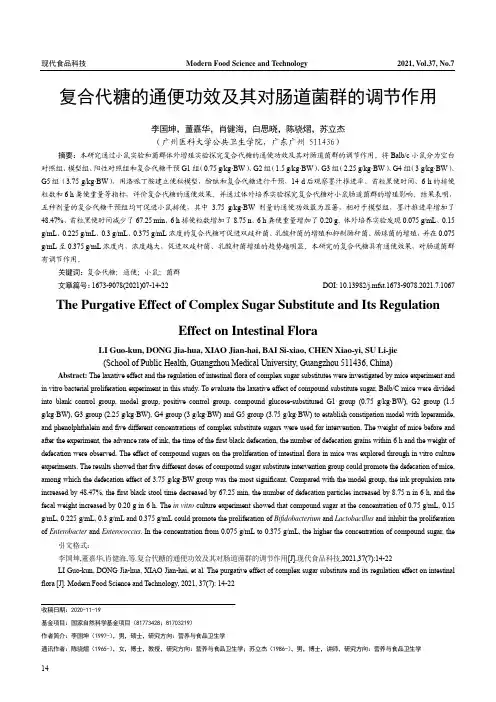
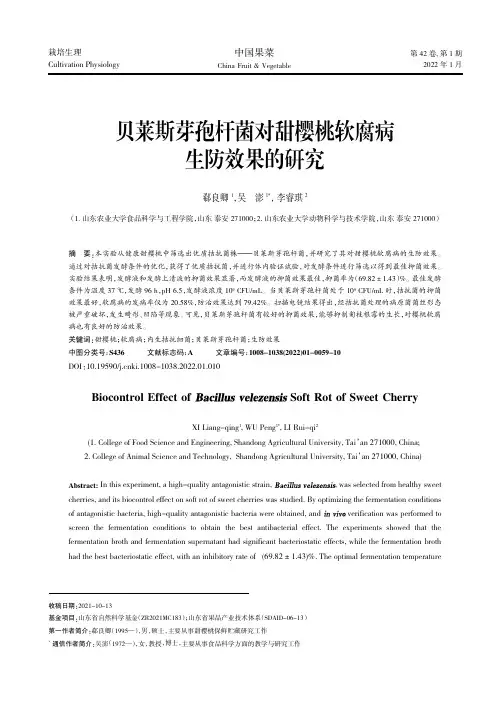
收稿日期院2021-10-13基金项目院山东省自然科学基金(ZR2021MC183);山东省果品产业技术体系(SDAID-06-13)第一作者简介院郗良卿(1995—),男,硕士,主要从事甜樱桃保鲜贮藏研究工作*通信作者简介院吴澎(1972—),女,教授,博士,主要从事食品科学方面的教学与研究工作
中国果菜ChinaFruit&Vegetable第42卷,第1期
2022年1月栽培生理
CultivationPhysiology
贝莱斯芽孢杆菌对甜樱桃软腐病生防效果的研究
郗良卿1,吴澎1*,李睿琪2
(1.山东农业大学食品科学与工程学院,山东泰安271000;2.山东农业大学动物科学与技术学院,山东泰安271000)
摘要院本实验从健康甜樱桃中筛选出优质拮抗菌株———贝莱斯芽孢杆菌,并研究了其对甜樱桃软腐病的生防效果。通过对拮抗菌发酵条件的优化,获得了优质拮抗菌,并进行体内验证试验,对发酵条件进行筛选以得到最佳抑菌效果。实验结果表明,发酵液和发酵上清液的抑菌效果显著,而发酵液的抑菌效果最佳,抑菌率为(69.82±1.43)%。最佳发酵条件为温度37益,发酵96h,pH6.5,发酵液浓度10
9CFU/mL。当贝莱斯芽孢杆菌处于109CFU/mL时,拮抗菌的抑菌
效果最好,软腐病的发病率仅为20.58%,防治效果达到79.42%。扫描电镜结果得出,经拮抗菌处理的病原菌菌丝形态被严重破坏,发生畸形、凹陷等现象。可见,贝莱斯芽孢杆菌有较好的抑菌效果,能够抑制匍枝根霉的生长,对樱桃软腐病也有良好的防治效果。关键词院甜樱桃;软腐病;内生拮抗细菌;贝莱斯芽孢杆菌;生防效果中图分类号:S436文献标志码:A文章编号:1008-1038(2022)01-0059-10
DOI:10.19590/j.cnki.1008-1038.2022.01.010
BiocontrolEffectofSoftRotofSweetCherry
XILiang-qing1,WUPeng1*,LIRui-qi2
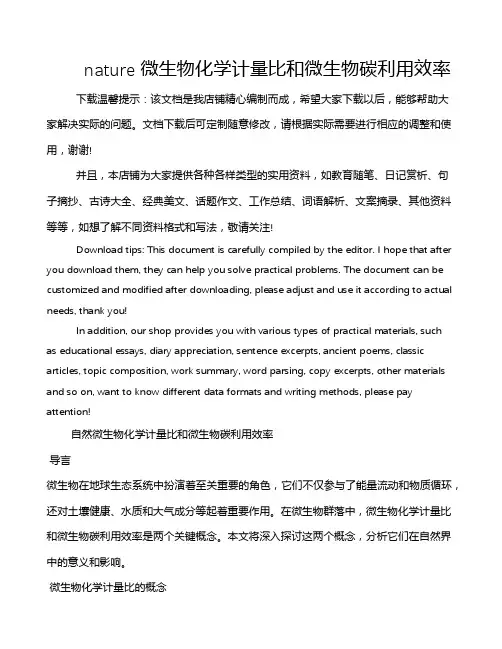
nature微生物化学计量比和微生物碳利用效率下载温馨提示:该文档是我店铺精心编制而成,希望大家下载以后,能够帮助大家解决实际的问题。
文档下载后可定制随意修改,请根据实际需要进行相应的调整和使用,谢谢!并且,本店铺为大家提供各种各样类型的实用资料,如教育随笔、日记赏析、句子摘抄、古诗大全、经典美文、话题作文、工作总结、词语解析、文案摘录、其他资料等等,如想了解不同资料格式和写法,敬请关注!Download tips: This document is carefully compiled by the editor. I hope that after you download them, they can help you solve practical problems. The document can be customized and modified after downloading, please adjust and use it according to actual needs, thank you!In addition, our shop provides you with various types of practical materials, suchas educational essays, diary appreciation, sentence excerpts, ancient poems, classic articles, topic composition, work summary, word parsing, copy excerpts, other materials and so on, want to know different data formats and writing methods, please pay attention!自然微生物化学计量比和微生物碳利用效率导言微生物在地球生态系统中扮演着至关重要的角色,它们不仅参与了能量流动和物质循环,还对土壤健康、水质和大气成分等起着重要作用。
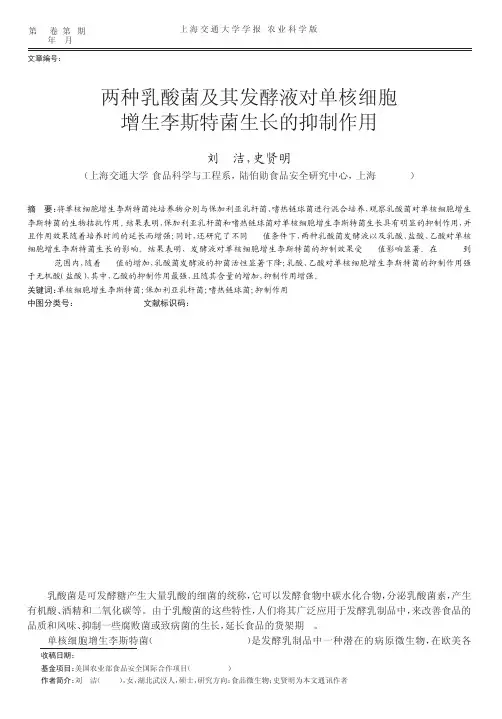
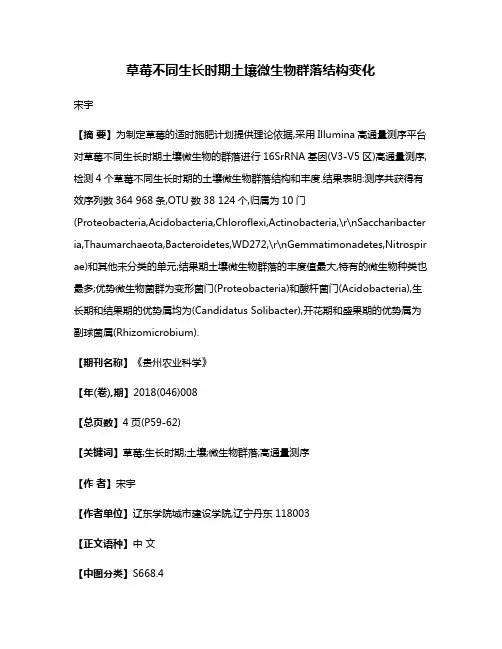
草莓不同生长时期土壤微生物群落结构变化宋宇【摘要】为制定草莓的适时施肥计划提供理论依据,采用Illumina高通量测序平台对草莓不同生长时期土壤微生物的群落进行16SrRNA基因(V3-V5区)高通量测序,检测4个草莓不同生长时期的土壤微生物群落结构和丰度.结果表明:测序共获得有效序列数364 968条,OTU数38 124个,归属为10门(Proteobacteria,Acidobacteria,Chloroflexi,Actinobacteria,\r\nSaccharibacter ia,Thaumarchaeota,Bacteroidetes,WD272,\r\nGemmatimonadetes,Nitrospir ae)和其他未分类的单元;结果期土壤微生物群落的丰度值最大,特有的微生物种类也最多;优势微生物菌群为变形菌门(Proteobacteria)和酸杆菌门(Acidobacteria),生长期和结果期的优势属均为(Candidatus Solibacter),开花期和盛果期的优势属为副球菌属(Rhizomicrobium).【期刊名称】《贵州农业科学》【年(卷),期】2018(046)008【总页数】4页(P59-62)【关键词】草莓;生长时期;土壤;微生物群落;高通量测序【作者】宋宇【作者单位】辽东学院城市建设学院,辽宁丹东118003【正文语种】中文【中图分类】S668.4土壤微生物是生态系统的重要组成部分,是土壤养分和有机质转化与循环的重要动力,在陆地生态系统中发挥至关重要的作用[1-2]。
土壤微生物在各方面影响着植物的生长发育,其群落的组成与活性也与植物生产力有关。
近年来,土壤微生物群落组成与多样性研究成为国际土壤微生物学、土壤生态学及全球变化生物学等领域研究的热点之一[3-5]。
传统的平板分离培养已不能很好地反映土壤中微生物类群的真实情况。
因此,将经典的平板培养技术和现代分子生物学PCR产物的变性梯度凝胶电泳技术相结合,极大地推动了根际微生物的研究,对根际微生物在各领域的应用发挥了极其关键的作用[6-7]。
BIOTECHNOLOGICALPRODUCTSANDPROCESSENGINEERINGDynamicsofbacterialcommunitiesduringsolid-statefermentationusingagro-industrialwastestoproducepoly-γ-glutamicacid,revealedbyreal-timePCRanddenaturinggradientgelelectrophoresis(DGGE)
XiaoyuYong&YaqingCui&LihuaChen&WeiRan&
QirongShen&XingmingYang
Received:28March2011/Revised:6May2011/Accepted:6May2011/Publishedonline:14June2011#Springer-Verlag2011
AbstractThedynamicsofbacterialcommunitiesplayanimportantroleinsolid-statefermentation(SSF).Poly-γ-glutamicacid(γ-PGA)wasproducedbyBacillusamyloli-quefaciensC1inSSFusingdairymanurecompostandmonosodiumglutamateproductionresidualsasbasicsub-strates.Theproductionofγ-PGAreachedamaximumof0.6%after20daysfermentation.Real-timepolymerasechainreactionshowedtheamountoftotalbacteriareached3.95×10916SrDNAcopies/gsampleafter30days,which
wasingoodaccordancewiththe4.80×109CFU/gobtainedbyplatecounting.Denaturinggradientgelelectrophoresisprofileshowedareductionofmicrobialdiversityduringfermentation,whiletheinoculum,B.amyloliquefaciensC1,wasdetectedasthedominantorganismthroughthewholeprocess.InthemesophilicphaseofSSF,Proteobacteriawasthedominantmicrobial,whichwasreplacedbyFirmicutesandActinobacteriainthethermophilicphase.ThemolecularanalysisofthebacterialdiversityhassignificantpotentialforinstructingthematuringprocessofSSFtoproduceγ-PGAatalarge-scalelevel,whichcouldbeabenefitintheproductionofhighqualityandstableSSFproducts.
KeywordsPoly-γ-glutamicacid(γ-PGA).Solid-statefermentation(SSF).Real-timePCR.Denaturinggradientgelelectrophoresis(DGGE).Dynamicsofbacterialcommunities
IntroductionAnaturallyoccurringanionicbiopolymer,poly-γ-glutamicacid(γ-PGA),whichwasfirstdiscoveredasacomponentinthecapsulesofBacillusanthracis(IvánovicsandErdos1937),iswater-soluble,biodegradable,edible,andnon-toxictohumanandtheenvironment,makingitusefulforvariousapplicationsinfood,cosmetics,medicine,agriculture,andtheenvironment(ShihandVan2001;Ashiuchi2010).Solid-statefermentation(SSF)hasbeenemployedtoproduceγ-PGAbyseveralgroupsusingsoybeancurd,sweetpotatoresidues,wheatbran,diarymanure,andswinemanurealoneorincombinationassubstrate(Chen2005;Xuetal.2005;Wangetal.2008b).Alargeamountofheatisgeneratedduringalarge-scaleSSF,whichisthemostcriticalfactorforcontrollingSSFprocess,sincetemperaturedirectlyaffectedthegrowth,sporeformationandgermination,themetabolicrate,andthepopulationstructureofmicrobials(Pandey2003;Sasakietal.2005).StudieshavereportedthatmicroorganismdiversityisdifferentduringSSFprocessbecauseoftheinitialmaterialsandthefermentationprocess(Yuetal.2009;Wangetal.2008a;Zhuetal.2003;Giraffa2004).Therefore,itisnecessarytodetectthetemperatureaswellasthemicrobialdiversityduringSSF.TraditionalanalysisofthemicrobialdiversityinSSFisprimarilybasedontheselective-platingmethod(Strom1985a,b).However,thisculture-dependenttechniqueisknowntoonlydetect0.1%to1%ofthebacterialcompositionofthetotalmicrobialcommunity(Headetal.1998;Amannetal.1995;Daniel2005).Inrecentyears,culture-independentmethodsbasedonmolecularbiologytechniques,suchasreal-timepolymerasechainreaction
X.Yong:Y.Cui:L.Chen:W.Ran:Q.Shen:X.Yang(*)JiangsuProvincialKeyLabforOrganicSolidWasteUtilization,NanjingAgriculturalUniversity,Nanjing210095,Chinae-mail:xingming@njau.edu.cn
ApplMicrobiolBiotechnol(2011)92:717–725DOI10.1007/s00253-011-3375-3(PCR)anddenaturinggradientgelelectrophoresis(DGGE),haveprovidenewmethodsforanalyzingthestructureandspeciescompositionofcomplexmicrobialcommunitiesinawiderangeofsamplesfromsoil(Innerebneretal.2006),compost(Danonetal.2008),andSSFproducts(Yuetal.2009;Giraffa2004;Harutaetal.2006).Althoughγ-PGAproducedbyfermentation(submergedfermentationandSSF)hasbeenpreviouslystudied,ithasonlybeenperformedwithpureculturesofisolatedstrains.Inthisstudy,alarge-scaleSSFwasconductedtoproduceγ-PGAbyBacillusamyloliquefaciensC1usingagro-industrialresidues,suchasdairymanurecompost(DMC)andmonosodiumglutamateproductionresiduals(MGPR)asbasicsubstrates.Real-timePCRandDGGEwereemployedtoenumeratethetotalbacteriaanddetectthemicrobialcommunities,respectively,whichcouldleadtoagoodidentificationofthedifferentSSFphasesandabetterdeterminationofthematuringprocessatthescale-uplevel.
MaterialsandmethodsThestrainusedinSSFThestrainB.amyloliquefaciensC1(ChinaGeneralMicro-biologicalCultureCollectionCenter(CGMCC)No.3478),isolatedbyourlaboratorywithahighγ-PGAproductionof18.3g/LinSMFand4.37%inSSF(20gsterilesubstratein250-mLflask),wasusedinthepresentstudy.C1wasinoculatedinto50-mLLuria-Bertani(LB)mediumandcultivatedonarotaryshakerat170rpmat37°Cfor14h(mid-logphaseofC1)untilthecellconcentration(OD600)